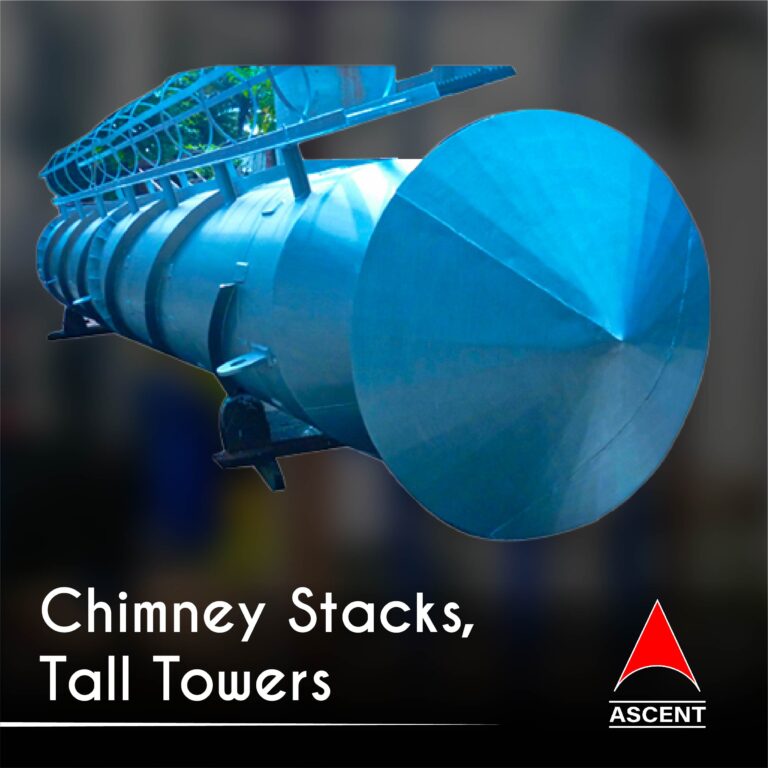
Home > Product Range > Industrial Process Equipment > Static Process Equipments > Chimney Stacks, Tall Towers etc.
Chimney Stacks and Tall Towers are critical components of industrial infrastructure, designed to vent exhaust gases, support communication systems, or serve as structural elements in large facilities. Built for durability, efficiency, and safety, these structures cater to industries such as power generation, oil and gas, chemical processing, and telecommunications. Their advanced designs ensure optimal performance while adhering to stringent environmental and safety regulations.
Ascent Machineries & Engineering Services Ltd., based in Goregaon, Mumbai, India, is a trusted manufacturer, supplier, and exporter of high-quality chimney stacks and tall towers. With a presence in over 80 countries, we provide innovative and customized solutions that meet international standards, ensuring reliability and long-lasting performance for diverse industrial applications.

Chimney stacks and tall towers are engineered to withstand extreme environmental conditions while maintaining structural integrity and efficiency.
| Model | Height (meters) | Material | Price (₹) |
|---|---|---|---|
| Compact Chimney Stack | Up to 50 | Steel | 15,00,000 |
| Standard Tower | Up to 100 | Reinforced Concrete | 50,00,000 |
| High-Capacity Tower | Up to 200 | Structural Steel | 1,20,00,000 |
Market Comparison:
Built to withstand extreme weather, seismic events, and high operational loads.
Advanced coatings and linings for long-term performance.
Designed to meet international safety standards, including ASME and ISO.
Tailored to meet specific industry and operational requirements.
Complies with environmental norms for emission control.
Available in various heights and diameters for diverse applications.
| Parameter | Details |
|---|---|
| Height | Up to 200 meters |
| Diameter | 500 mm–5,000 mm |
| Material Options | Structural Steel, Concrete |
| Lining Material | Acid-Resistant Ceramics |
| Wind Load | Designed for up to 200 km/h |
| Seismic Load | Meets zone-specific standards |
| Coatings | Anti-Corrosive, Thermal Insulation |
| Country of Origin | India |
Lightweight and durable for medium to high exhaust loads.
Ideal for heavy-duty applications in power plants.
Designed for communication systems and light loads.
Cost-effective solutions for taller installations with minimal footprint.
Cities: Mumbai, Delhi, Chennai, Bangalore, Dubai, Kuala Lumpur, and more.
Countries: India, UAE, Malaysia, South Africa, Kenya, UK, USA, Australia, and Vietnam.





Yes, our stacks are designed with acid-resistant linings to handle such conditions.
Absolutely, we provide tailored solutions to meet specific industrial requirements.
Delivery timelines range from 8 to 12 weeks, depending on project specifications.
Enhance your industrial infrastructure with Ascent Machineries & Engineering Services Ltd.‘s robust chimney stacks and tall towers. Contact us today for customized solutions tailored to your operational needs.
ASCENT MACHINERIES & ENGG. SERVICES Shop No. 2, 1st Floor, Nalanda Shopping Center, Station Road, Goregaon West, Mumbai - 400062, Maharashtra, India
+919819063898
sales@ascentmes.com
© 2025 Ascentmes.com. All rights reserved. Designed by Vebiotic Web Solutions Marketing by Adinads